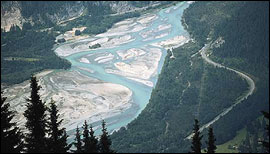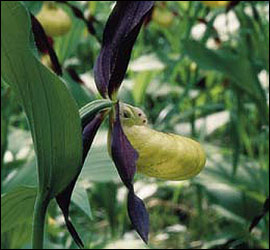 |
Getting back to nature
|
 |
Changes to the natural environment
had a negative impact
on the fluvial system, such as the separation of the Lech River from
its side waters, a drop in groundwater levels, and dry-running of
floodplain areas. |
The LIFE project marks a milestone in the effort to create ecologically sound water habitats and promote understanding for the preservation of this natural area.
The Lech Valley of Tyrol is dominated by the appearance of the
Lech River. The wide-ranging floodplain forests and habitats cover over
40 square kilometres and boast an impressive ecological variety. The valley,
however, is at risk of losing these precious habitats due to flooding and
over-management of the river.
The Lech valley of Tyrol is part of the Natura 2000 network, and forms the
geographical frame for the LIFE-Nature project at the Lech River. The Lech
River Valley is home to a number of rare or endangered species. Grasshoppers
such as the gravel bed grasshopper or Türk’s groundhopper, both
of which can still be found at the Lech River, require habitats of raised
alpine river gravel banks and are therefore endangered. Furthermore, Bilek’s
azure damselfly, discovered only as recently as 1952, makes it home nowhere
else but the Tyrolean Lech Valley.
The river takes a new direction.
The Lech River undoubtedly plays an essential role in the lives and habitats
of the people living by it. For many years, protection from floods and creation
of land were the main interests of the local population. Structural measures
in the form of dams and spur dikes were constructed to tame the flow of
water and keep the river in a smaller river channel to gain ground. However,
the smaller river channel increased the damage during floods and these constructions
increased the velocity resulting in riverbed sinking. “With the start
of the LIFE project there were several probing questions and irritations,”
says District Commissioner Dietmar Schennach. “Why is the riverine
forest being destroyed, why are the pine forests being cut down, why are
there so many digging actions in the Lech?”
The sinking of the riverbed has led to further negative impacts on the fluvial
system, such as the separation of the Lech River from its side waters, a
drop in groundwater levels, and dry-running of floodplain areas. In addition,
dams, which were constructed to protect settlements from high water, are
in danger of washout. Thus, not only are rare plant and animal species endangered
and natural habitats lost, but local settlement areas are also at risk.
 |
The Lady Slipper orchid, named
for its large yellow blooms resembling a slipper,
is an endangered species in Austria. The delicate plant prefers the
half-shade of the floodplain forests, and flowers from May to July. |
Removing the ties that bind the river.
The aims of the LIFE project, called Wild River Landscape of the Tyrolean
Lech, are to conserve and return the dynamic fluvial habitats to a more
natural state. The LIFE project will remove these dams to give the river
more room again, including areas near the Johannis Bridge and the River
Vils at the Marinau Hamlet. Moreover, the bed load protection at the river
feeders will be removed to ensure unobstructed bed load transport at the
Hornbach and Schwarzwasserbach brooks.
Removing these man-made attempts to tame the river will create new riverbanks
to support rare plants, such as the dwarf cattail, by recreating their former
habitats. Endangered species such as lady’s slipper, azure damselfly,
special orchids and fish will be preserved by resettlement and maintenance
of habitats. Furthermore, the team plans to develop new pools for amphibians
and dragonflies. Egon Bader, of the Tyrolean Nature Conservatory, is optimistic
about the far-reaching effects of the programme: “The Natura 2000
site doesn’t just provide protection for the river ecostystem and
its riverine forests, it makes revitalisation of high value habitats possible,
and safeguards flora and fauna.”
A LIFE information point along the river in Weissenbach will serve as an
information hub for excursions and events within the LIFE project and will
provide a location for leisure time activities, recreation and the experience
of nature. Moreover, observation
platforms and adventure paths will encourage a positive drive for environmentally
sustainable tourism. The team project marks a milestone in the effort to
create ecologically sound water habitats and promote
understanding for the preservation of this natural area — for the
well-being of river habitats and for the well-being of the people who live
in this region. Local resident Siegfried F. Kerle sums it up by saying,
“The LIFE project gives the region along the Lech River the attention
and respect
for nature that this beautiful landscape
really deserves.”
THE LIFE PROJECT
Launched in 1982, LIFE is the financial instrument for the Environment
of the European Commission. LIFE co-finances initiatives in the European
Union and in Central and Eastern European accession candidate countries.
The project includes a total of 53 individual projects, which began in 2001
and will continue until 2006.
What makes the Lech project so special is that it is a
joint project with organisations from different fields and interests. Partners
include: Government of Tyrol; Department for Nature Conservation and Water
Management; Austrian Ministry for Agriculture, Forestry, Environment and
Water Management; Forest Technical Service for Torrent and Avalanche Control;
and World Wide Fund for Nature (WWF). A total of 7.82 million Euro are available
in order to carry out the project, which is also to have positive
economic impacts on the region. Half the cost of the project is
funded by the European Union; the remaining costs are shared among the partners.
For more information visit:
www.tiroler-lech.at
www.zeitfluss.at
www.wwf.at